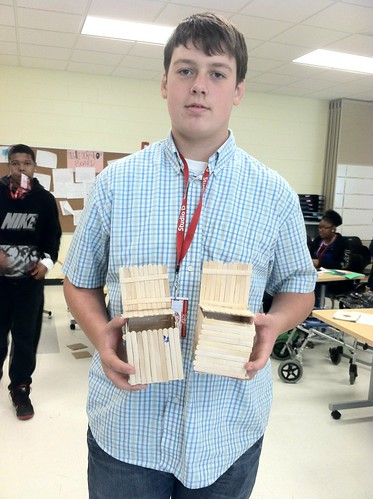Today's lesson is brought to you by the word Busy.
We're flying a man down today with Coach West being out, so our groups are working in rotation 3. The Pallet Garden group is their own rotation. The French Drain group and the Storage Chair are in another group, and finally the Storage Chest and Octangular Table are in a group. Groups worked with me on completing their Bird's Eye View of the Space and together we put together a tentative floor plan for our Outdoor Learning Space.
Here's what we are up to (as of now):

You can't see the grid lines on the graph paper but the entire space is 30' x 30'. The designs represented are of the square footage each item would take up in the space. The left side of the design is primarily pallet gardens that students plan to fill with native plants that will attract native wildlife. The storage chests are on the right side of the space and are multifunctional and can serve as seating too. What we don't have pictured yet is our Octangular Table and Benches, and our Storage Chairs. Those two design teams were having a difficult time converting their imagined measurements into real life square feet. Being the non-math expert that I am, I sought out a math expert in our own Student Activities Director Mrs. Janet Frick. She and a few of our students had a chat about how to find square footage of a square, and how to find the circumference of a circle when we know the diameter. Check her out working her math magic!
Students were then able to calculate their measurements and give an accurate representation of how much space their design would need. It was great to have some help. Math was never my thing....
Some groups, like our Storage Chest, Octangular Table, and one other group were able to begin their new and revised prototypes. They have to create one prototype for every object they plan on putting in the space, and it must be done exactly to a predetermined scale. This will probably take us to the end of tomorrow.
.jpeg) |
Our Octangular Table group debating on their table top
design. |
.jpeg) |
| One of the table top design possibilities. |
.jpeg) |
The same group working on their new bench prototype.
|
In Mrs. Soblo's class, students are creating an educational tool that can be used in the outdoor learning space to identify some of the organisms that can be found on campus. Each student finds 13 unique species that we've seen here or are very common in the area. The task then is to research the organisms they select to create a tool for identification, listing what the organism looks like, how it's different from similar species & other interesting facts. Students need to include citations of the resources they use in their research & for images they add.
Many students are creating field guides (paper & online versions), but a few students are creating games. Students can work in teams in order to create a larger field guide- for example: 2 students need 26 species, 3 students need 39 species.
Timeline for completion is 12/3 for the finished product.
With Mrs. A, students have been practicing their citation skills. From Mrs. A herself: Following prior direct instruction on plagiarism and how to avoid it (including how to use direct quotes and how to paraphrase information), students have recently taken notes more specifically on how to properly give credit to sources at the end of a paper or research project. The focus has been on
electronic source material, since most students are using primarily these types of sources. Students had to learn how to identify what type of electronic source they were viewing, where to find information like title, author, publisher, date, etc. on each website, how to create citations in MLA style, and how to format the final works cited page. After an introduction to these concepts and skills, students used their notes to create a works cited page (using 5 arbitrary website sources of various types). This assignment was then awarded a score, based on the accuracy of each individual citation as well as overall formatting, and students were given individual feedback about where they made errors.
Based on the results of this assignment, it was clear that most students had not mastered these concepts and skills; therefore, after a brief reteaching of the content, students were asked to try again, with a new set of 5 arbitrary website sources of various types. This new assignment will result in a new works cited page that, after feedback and reteaching, is expected to be more accurate than the first attempt. Students will be allowed to replace their initial grade with their new (presumably higher) grade. It is expected that at this point many students will have mastered some of the basic skills involved, but it is also expected that due to the available variety of electronic sources alone, students will need continuous practice with this throughout the year to expose them to all the possibilities (and differences in citations) of source material. It is clear, through observations and discussions with students, that most are aware that the most important and difficult step when crediting sources seems to be determining what type of electronic source they are using. The next lesson, in addition to continued practice creating works cited pages, will involve examining sources for bias and evaluating sources for validity, usefulness, etc. Meanwhile, we will continue to work on effectively incorporating source material into writing.
Here's the assignment from Mrs. A if you were planning to BINGO her citation practice.
So....we're busy. Just in case you wanted to know. Busy days in the Studio are all we see in our future. Make sure you keep up with all the action right here!




.jpeg)
.jpeg)
.jpeg)
.jpeg)
.jpeg)
.jpeg)
.jpeg)






